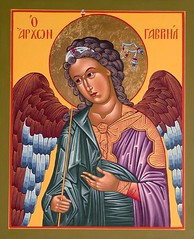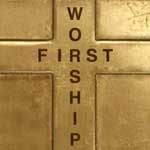Christ’s invitation into communion is not answered when the only thing that’s mutual is our suspicion. Thus, I am deeply grateful for the work that Metropolitan Jonah is undertaking on behalf of all Orthodox Christians in re-establishing trustworthy common ground with those of us who walked the way of Orthodoxy within the realms of the Latin Rite estrangement. By Archbishop Methodios Fouyas, 1972
By Archbishop Methodios Fouyas, 1972As we try to see the Anglican Church with Orthodox eyes we must remember that clear-cut definitions are ruled out in advance where Anglicanism is concerned. Judged by the principles of the Orthodox Church, the Church of England had the right to proclaim itself self-governing and autonomous, provided that there were certain canonical principles, which in fact there were. The old Church of England went on without any breach in either its legal or its spiritual continuity.
It continued to profess the Catholic faith, which was once for all delivered to the Saints.
It preserved without any break the Apostolic Succession of its Ministry, 1 although 'many Anglicans maintain Apostolic succession primarily as a symbol and Bond of Unity.'2
Some Anglican theologians have considered Episcopacy to be not only of the
bene esse of the Church, but part of its
esse, as Canon Richardson says. 3 Consequently Orthodox theologians, influenced by the writings of Anglicans like Gore 4 and A. M. Ramsey, 5 have accepted that the Church of England means by Apostolic succession 'that grace is bestowed by our Lord, through the action of His whole Church. But certain actions in this work of grace are confined to Bishops, whereby the truth is taught that every local group or Church depends on the one life of the one Body.'6 We find a similar opinion to that of Archbishop Ramsey in G. W. Broomfield's book
Revelation and Reunion, in which he writes: 'there seems to me to have been a general principle implicit in Apostolic practice, and underlying the evolution of Church order. This was that appointments to the official ministry are the business of those who themselves have received authority to make such appointments.'7
As Archbishop Ramsey has written recently:
Our Church has two aspects: On the one hand we claim to be a Church possessing Catholic Tradition and continuity from the ancient Church, and our Catholic Tradition and continuity includes the belief in the real Presence of Christ in the Blessed Sacrament; the order of Episcopacy and the Priesthood, including the Power of a priestly absolution. We possess various institutions belonging to Catholic Christendom like monastic orders for men and women. Our Anglican Tradition has another aspect as well. We are a Church which has been through the Reformation, and values many experiences derived from the Reformation, for instance, the Open Bible: great importance is attached to the authority of the Holy Scriptures, and to personal conviction and conversion through the work of the Holy Spirit.8
What we have said about the Orthodox attitude towards Rome applies to some extent also to the Orthodox attitude towards Anglicanism. The Orthodox belief that their Church is the one Holy, Catholic, and Apostolic Church on earth, gives the impression that Orthodox theology is even more exclusive than Roman Catholic. But the Orthodox Church has shown some recognition of the sacraments of other churches. For instance, her practice of receiving converts from Rome or Anglicanism by Chrismation without Re-baptism (though this has not always been the case in the past) 'is a clear indication that the sacramental limits of the Church do not coincide with its ceremonial boundaries'.9
Orthodox theologians are divided as regards the character of the Anglican Church. Some see it from the exaggerated point of view which divides it into three parties, commonly known as High Church, Low Church, Broad Church. It is this idea that leads many, not only Orthodox, but Roman Catholics also, to think that the Church of England is a sort of confederation of three separated Churches, each with its own liturgy, its own doctrinal formularies and its own separate hierarchy. This is completely mistaken.
Dr. Ramsey says that
though there is High Church and Low Church, it is all the time One Church with a single life, and all the members of the Church of England share together in the Creeds, Holy Scriptures, the Sacraments, the rule of the Bishops and the Liturgy; so do not think of High Church and Low Church as utterly separate factions but as two aspects of the life of a Church which is all the time one.10
Some Orthodox theologians judge the Church of England from the Thirty-Nine Articles alone, which prevents them from having a true appreciation of this Church from an Orthodox point of view. 11
The Articles bear little relation to the present life of the Church, but are polemical principles long ago established. The Articles do not represent the whole Faith of this Church.
In these matters the Orthodox attitude towards the Anglican Church sometimes tends to be ill-informed. 12 When the Anglican Church and its tradition is more fully understood by the Orthodox, I am sure it will be recognized that Anglicanism represents a genuine spirit of Orthodoxy so developed as to be understood by modern thought.
Anglicanism is not a Protestant Church, but a reformed Catholic Church, which maintains its unity with the tradition of the ancient undivided Church.Professor Comnenos, in his book on Anglican orders, wrote that 'very many of the lay and clerical members of the Anglican Church are inclined to be Orthodox in mind and would gladly enter into union with Orthodoxy, or otherwise fully communicate with it, if the non-recognition of their Priesthood did not stand before them as an insurmountable obstacle.'13 A leading Orthodox personality, Germanos, Archbishop of Thyateira, speaking at the Gloucester Diocesan Conference on I June 1923, said that 'the Orthodox Church has always considered the venerable Anglican Church as a branch, in many particulars, in continuous succession with the Ancient Church'.14
By a branch, Archbishop Germanos meant not one of the parts of Catholicism, according to the Branch Theory, but a Church especially representing the Catholic Church in England. Similarly Professor Bulgakov writes that 'Anglicanism in its tendency towards the restoration of the Ancient Church, as a reaction to Protestantism, is already becoming more and more Orthodox, and this process is naturally a way to its reunion with historic Orthodoxy.'15
____________________________
1
The Claims of the Church of England, Cyril Garbett (London, 1947), p. 15, 17, 55
2
The Second World Conference on Faith and Order (1938), p. 246. Such was the opinion of the Archbishop of Canterbury, Randall Davidson, cf. H. D'Espine, 'The Apostolic Succession as an Ecumenical issue. A Protestant View', E.R. iv (1952), pp. 154-155, and of William Temple, cf. F. A. Iremonger,
William Temple, Archbishop of Canterbury, His Life and Letters (1948), p. 586.
3 C. C. Richardson,
The Sacrament of Reunion (194.0). See G. K. A. Bell,
Christian Unity: The Anglican Position. Okus Petri Lectures at Upsala University, October, 1946 (London, 1948), pp. 23-31. Appendix: Extracts from Anglican Writers on Episcopacy.
4
The Ministry of the Christian Church, pp. 65-109.
5
The Gospel and the Catholic Church, pp. 81-6, 216.
6 Cf. also Daniel Jenkins, in
The Nature of Catholicity (1942), p. 54. Jenkins endorses Ramsey's opinion, although he thinks that such a claim comes with a shock of surprise to many modern Protestants.
7 G. W. Broomfield,
Revelation and Reunion (1942), p. 185.
8
Catholic Herald, 17 Sept. 1965; cf. Gore, The Anglo-Catholic Movement, p. 7.
9 N. Zernov, H.E.M., p. 673. 10
Catholic Herald, loc. cit.
11 Such was the attitude of the Russian Orthodox Church during the Russo-Anglican discussions in Moscow, July 1956; cf. H. M. Waddams,
Anglo-Russian Theological Conference, pp. 64-65. Cf. also
Conferinta Romana Orthodoxa-Anglicana tinuta la Bucuresti y-Sjunie 1935 si Calatoria I.P.S. Patriarchului D. D. Dr Miron in Anglia 28junie-7 julie 1936. Bucharest, 1938.
12 e.g.
Trembelas, The History of the Reformation in the Anglican Church, p. 124.
13 P. Comnenos, 'Anglican Ordinations', C.E. ii (1921), p. 113.
14 C.E. v (1924), p. 128.
15 S. Bulgakov, 'One, Holy, Catholic and Apostolic', C.E. xii (1931), pp. 95-6. I do not ignore the Letter of Khomyakov to W. Palmer, where the Russian Orthodox thinker defines Anglicanism: 'It is a narrow ledge of dubious
terra firma, beaten by the waves of Romanism and Protestantism, and crumbling on both sides into the mighty waters': quoted in W. J. Birkbeck,
Russia and the English Church, pp. 102-3. But this extreme idea on Anglicanism has never found acceptance amongst Orthodox theologians.






















